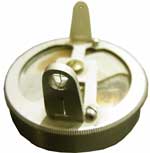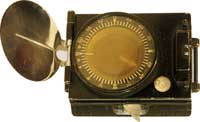Compass surveying is a type of surveying in which the directions of surveying lines are determined with a magnetic compass, and the length of the surveying lines are measured with a tape, chain, or laser range finder. The compass is generally used to run a traverse line.
Survey Compass Pictured Courtesy of Compass Museum
What is a Survey Compass?
A Survey Compass, otherwise known as Circumferentor, is an instrument used in surveying to measure horizontal angles. It was superseded by the theodolite in the early 19th century. A circumferentor consists of a circular brass box containing a magnetic needle, which moves freely over a brass circle, or compass divided into 360 degrees. The needle is protected by a glass covering. A pair of sights is located on the North-South axis of the compass. Circumferentors were typically mounted on tripods and rotated on ball-and-socket joints. Circumferentors were made throughout Europe, including in England, France, Italy, and Holland. By the early 19th century, Europeans preferred theodolites to circumferentors. However, the circumferentor remained in common use in mines and in wooded or uncleared areas, such as in America.
What is a Land Surveyor Compass? A Comprehensive History to Modern Times
A Survey Compass, also known as a Circumferentor, is an essential instrument in the field of surveying, used primarily for measuring horizontal angles. This tool played a crucial role in the development of land surveying techniques and has a rich history that spans several centuries. Despite being largely superseded by more advanced instruments such as the theodolite in the early 19th century, the Survey Compass remained in use for specific applications, particularly in challenging terrains like mines and wooded areas. This article delves into the detailed history, evolution, and modern adaptations of the Survey Compass, highlighting its significance in the surveying field.
The Origins of the Survey Compass
The origins of the Survey Compass can be traced back to the early developments in navigation and land surveying. The need for accurate measurement of land boundaries and the determination of property lines spurred the invention and refinement of various surveying instruments. The Survey Compass, or Circumferentor, emerged as a pivotal tool during this period.
The Structure of a Survey Compass
A traditional Circumferentor consists of several key components:
- Circular Brass Box: This contains the magnetic needle, which moves freely within the box.
- Magnetic Needle: The needle aligns with the Earth's magnetic field, pointing towards the magnetic north.
- Brass Circle: The circumference of the box is divided into 360 degrees, allowing for precise angle measurements.
- Glass Covering: Protects the needle and the internal components from dust and damage.
- Sights: A pair of sights is located on the North-South axis, aiding in the accurate alignment and measurement of angles.
- Mounting: Typically, the Circumferentor is mounted on a tripod and can rotate on a ball-and-socket joint, providing stability and ease of use.
Early Uses and Development
In the early days of its use, the Circumferentor was an indispensable tool for surveyors. It facilitated the accurate measurement of horizontal angles, which was essential for mapping and delineating property boundaries. The instrument's simplicity and effectiveness made it popular across Europe, including in countries like England, France, Italy, and Holland.
The Evolution of Surveying Instruments
By the early 19th century, the field of surveying saw significant advancements with the introduction of more sophisticated instruments. The theodolite, with its ability to measure both horizontal and vertical angles, began to replace the Circumferentor in many applications. However, the Survey Compass remained in use in specific contexts where its simplicity and reliability were advantageous.
The Theodolite: A Superior Successor
The theodolite, which could measure both horizontal and vertical angles with greater precision, represented a significant technological leap. It allowed surveyors to perform more complex measurements and achieve higher accuracy, which was particularly beneficial for large-scale mapping and engineering projects. Despite this, the Circumferentor retained its place in certain applications due to its robustness and ease of use.
Continued Use in Challenging Terrains
One of the notable aspects of the Survey Compass is its continued use in challenging terrains. In mines and wooded or uncleared areas, where more delicate instruments like the theodolite might be impractical, the Circumferentor proved to be a reliable tool. Its sturdy construction and straightforward operation made it ideal for such environments, ensuring that surveyors could still perform accurate measurements in difficult conditions.
The Circumferentor in America
In America, the Circumferentor found widespread use, particularly in the early days of the nation's expansion. Surveyors tasked with mapping the vast and often rugged landscapes of the American frontier relied on the Survey Compass for its durability and effectiveness. The instrument played a crucial role in the westward expansion, aiding in the creation of accurate maps and property boundaries.
Technological Advancements and Modern Adaptations
With the advent of electronic and digital technologies, the field of surveying has undergone significant transformations. Modern surveying instruments incorporate advanced features such as electronic angle measurement, GPS integration, and data recording capabilities. Despite these advancements, the principles established by the Circumferentor continue to underpin many modern surveying techniques.
Total Stations and GPS Surveying
Today, surveyors commonly use total stations, which combine the functions of a theodolite with electronic distance measurement (EDM) technology. These instruments provide highly accurate measurements and can store data digitally, streamlining the surveying process. GPS technology has further revolutionized the field, enabling surveyors to determine precise locations with satellite-based positioning systems.
The Legacy of the Survey Compass
The Survey Compass, or Circumferentor, holds a significant place in the history of surveying. Its invention and use marked a critical step in the development of land surveying techniques, paving the way for the advanced instruments used today. The legacy of the Circumferentor is evident in the continued emphasis on accuracy, reliability, and simplicity in modern surveying tools.
Conclusion
The Survey Compass, known as the Circumferentor, has a storied history that highlights its importance in the field of surveying. From its origins in early navigation to its role in the expansion of the American frontier, the Circumferentor has proven to be a vital tool for surveyors. While modern technology has introduced more sophisticated instruments, the fundamental principles established by the Circumferentor remain relevant. Its legacy continues to influence the design and use of contemporary surveying tools, ensuring that the Survey Compass remains a significant part of the history and practice of land surveying.
Survey Compass (Compass Museum)
No maker indicated. Maybe Austrian (discovered in Vienna). Early 20th c. Probably used together with a special device like a tripod. The double graduation (quadrants on disc and casing) is evidence of its use for survey works.
Germany, Sitometer
What is the Difference Between a Surveyor Compass and a Prismatic Compass?
| Prismatic Compass | Surveyor Compass |
|---|---|
| In this compass, the readings are taken with the help of a prism. | There is no prism on it. Readings are taken with naked eyes. |
| With the help of a prismatic compass, whole circle bearing (W.C.B) can be measured. | With the help of a surveyor compass, reduced bearing can be measured. |
| Graduation in prismatic compass are marked from 0° to 360°. | |
| In a prismatic compass, a mirror is provided with the sight vane. | In a surveyor compass, no mirror is attached to the objective vane. |
| Sighting the object as well as reading the graduated circle can be done simultaneously without changing the position of the eye. | Sighting the object as well as reading the graduated circle cannot be done simultaneously without changing the position of the eye. |
Surveyor Compass History Tidbit
As most of you know, America's First President, George Washington, was a land surveyor. George Washington (1732-1799), the 1st president of the U.S., worked about 3 years as a surveyor when he was 16-19. He maybe laid down the system of plats for the new territories (see LEUPOLD). He was interested in surveying during his whole life and utilized instruments made by RITTENHOUSE (click on the link to see the picture of an engraved compass).
Surveyor Compass Tool I built (experimental)
To effectively use the Digital Surveying Compass with Street View, follow these detailed instructions:
Setup and Interface Overview
-
Load the Interface:
- Open the provided HTML file in your web browser.
- Ensure you have an active internet connection for the street view feature.
-
UI Components:
- Compass: Located at the center, displaying a needle and the current direction.
- Buttons:
Fetch Geolocation: Retrieves your current location and displays it.Add Waypoint: Marks a waypoint based on the current compass direction.
- Sign In and Sign Up Buttons: Located at the top right corner for user authentication.
- Geolocation Display: Shows the current latitude and longitude after fetching location.
Using the Compass
Manual Direction Setting
- Move Your Mouse:
- The needle will rotate based on your mouse movement relative to the compass center.
- The direction (N, NE, E, SE, S, SW, W, NW) updates dynamically.
Fetching Your Geolocation
- Click
Fetch Geolocation:- The browser will request access to your location.
- Grant permission when prompted.
- Your latitude and longitude will be displayed.
- The background will update with a Google Street View image of your current location.
Adding Waypoints
- Click
Add Waypoint:- A yellow waypoint marker will appear.
- The marker’s position is calculated based on the current direction of the compass needle.
- The waypoint helps visualize a specific direction from your current location.
Modals and Authentication
- Sign In and Sign Up:
- Click
Sign InorSign Upto open a modal window for authentication. - The modal displays a login/signup form from Land Surveyors United.
- Use the
Closebutton inside the modal to exit.
- Click
Detailed Steps and Tips
-
Interacting with the Compass:
- Move your mouse slowly to observe how the needle aligns with your cursor.
- The needle’s rotation origin is at the bottom center, ensuring accurate direction display.
-
Fetching Geolocation:
- Ensure geolocation services are enabled in your browser.
- Upon successful location retrieval, check the displayed latitude and longitude for accuracy.
- The street view background provides a visual context of your location.
-
Adding Waypoints:
- Ensure the needle is pointing in the desired direction before clicking
Add Waypoint. - The waypoint’s position is calculated to be 100px away from the compass center, directly along the needle’s direction.
- Ensure the needle is pointing in the desired direction before clicking
Additional Notes
- Error Handling:
- If geolocation fails, a message will indicate the reason (e.g., access denied or unsupported browser).
- Customization:
- The street view feature uses a Google Maps API key. Ensure it is valid and has the necessary permissions.
- Adjust the compass size, waypoint distance, and other styles in the CSS section as needed.
Example Use Case
- Scenario:
- You are in the field and need to determine a direction for a new survey point.
- Procedure:
- Open the Digital Surveying Compass.
- Click
Fetch Geolocationto determine your current position. - Use the compass to set the direction for your new survey point.
- Click
Add Waypointto mark this direction visually.
- Result:
- Your screen will display the current location, street view, and a visual waypoint marking the direction from your position.
By following these instructions, you can utilize the Digital Surveying Compass effectively for navigation and surveying purposes.










Thoughts
Whoever set up this discussion page... PLEASE DO NOT FORMAT IT WITH YELLOW TEXT ON A WHITE BACKGROUND!!!!!
Yes that looked awful... fixed now..